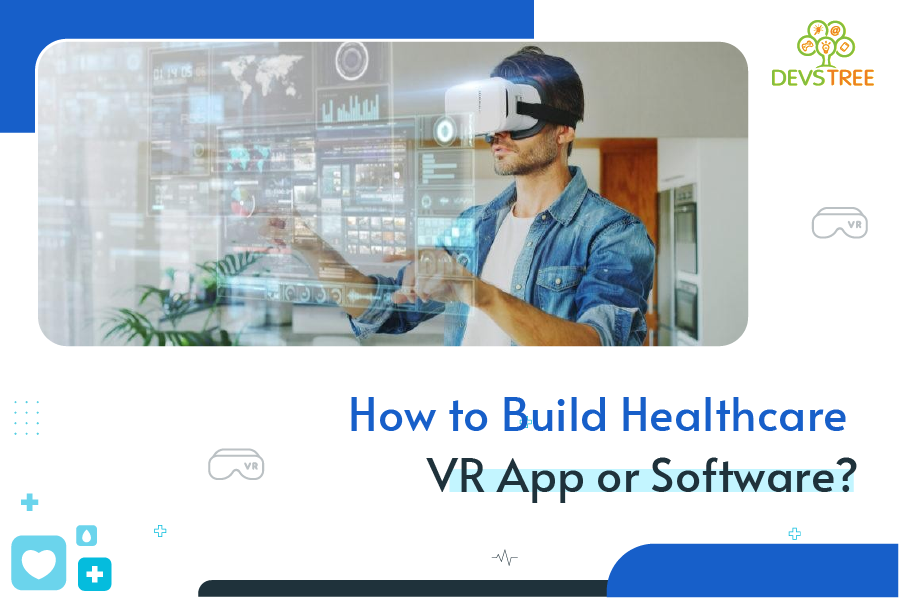
In recent years, Virtual Reality (VR) technology has made significant strides, transforming various industries, including healthcare. Healthcare VR apps and software have emerged as powerful tools to enhance medical training, patient care, and therapeutic interventions.
In this blog post, we’ll delve into what a Healthcare VR app is, how it works, and provide a step-by-step guide on developing one. Additionally, we’ll discuss the reasons behind the growing trend of healthcare VR apps and estimate the associated development costs.
What is a Healthcare VR App?
A Healthcare VR app is a virtual reality application designed specifically for the healthcare sector. It utilizes VR technology to simulate realistic environments, procedures, or scenarios that can be used for medical training, patient education, and therapeutic purposes. These apps can range from surgical simulations to mental health interventions, offering a wide array of possibilities to improve healthcare services.
How Does a Medical VR App Work?
Healthcare VR apps leverage VR headsets and controllers to immerse users in a virtual environment. These environments can replicate medical scenarios, enabling users to interact and practice in a risk-free setting. For example, surgeons can practice complex procedures, medical students can explore anatomy in 3D, and patients can undergo virtual therapy sessions. The technology relies on realistic graphics, 3D models, and interactive elements to create a lifelike experience.
Why Should You Build a Healthcare VR App?
Enhanced Training and Education: Healthcare professionals can practice and refine their skills in a controlled virtual environment, reducing the risk associated with real-world procedures.
Patient Engagement and Education: VR apps can be used to educate patients about medical conditions, treatment options, and recovery processes, fostering better understanding and adherence to treatment plans.
Therapeutic Interventions: VR has shown promising results in treating various mental health conditions, such as anxiety and PTSD. VR-based therapies provide a immersive and controlled space for therapeutic interventions.
Remote Consultations: VR can facilitate remote consultations, enabling healthcare providers to connect with patients in a virtual space, especially useful in situations where physical presence is challenging.
How to Develop a Healthcare VR App or Software?
Define Objectives and Use Cases:
Clearly outline the goals of your VR app, whether it’s for training, patient education, or therapy.
Identify specific use cases and scenarios your app will address.
Choose the Right VR Platform:
Decide on the VR hardware and platform that aligns with your app’s objectives (e.g., Oculus Rift, HTC Vive, or mobile VR platforms like Oculus Quest).
Content Creation:
Develop or acquire 3D models, realistic simulations, and interactive content that align with your app’s purpose.
Software Development:
Choose a development framework suitable for healthcare VR app development.
Focus on creating a user-friendly interface and seamless interactions within the virtual environment.
Integrate Data Security Measures:
Implement robust security protocols to protect sensitive healthcare data if your app involves patient information.
User Testing:
Conduct extensive testing to ensure the app’s functionality, realism, and user experience meet the intended goals.
Regulatory Compliance:
Ensure your healthcare VR app complies with relevant healthcare regulations and standards.
How Much Does it Cost to Develop a Healthcare VR App?
The cost of developing a healthcare VR app can vary based on factors such as complexity, features, and platform. A simple VR app may cost tens of thousands of dollars, while more complex applications could range into the hundreds of thousands or more. Consider expenses for content creation, software development, hardware, and ongoing maintenance.
In conclusion, building a healthcare VR app requires careful planning, a focus on user experience, and adherence to regulatory standards. The potential benefits in training, patient care, and therapeutic interventions make the investment worthwhile, contributing to the advancement of healthcare technology.
